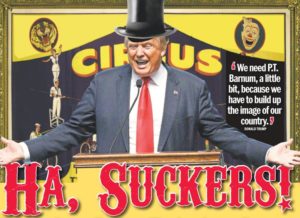Picktures and Pieces 11: “What Is and What Seems to Be”
by Randall Auxier
 Here is an interesting image. I think you’ll agree. I’m glad that it exists. It made me laugh and laugh when I first saw it, several years ago. It was in a collection of funny photographs on one of those social media impulse-click sidebars, the ones designed to suck up hours of your time while you essentially look at advertising. The caption said “Who thought it was a good idea to bring the cat?” The simple incongruity is the basis of the humor. But it has a deeper basis too: the relationship between possibility and actuality. Of course it’s possible to drag a cat into an adventure like this, but who would actually do it?
Here is an interesting image. I think you’ll agree. I’m glad that it exists. It made me laugh and laugh when I first saw it, several years ago. It was in a collection of funny photographs on one of those social media impulse-click sidebars, the ones designed to suck up hours of your time while you essentially look at advertising. The caption said “Who thought it was a good idea to bring the cat?” The simple incongruity is the basis of the humor. But it has a deeper basis too: the relationship between possibility and actuality. Of course it’s possible to drag a cat into an adventure like this, but who would actually do it?
And there’s the rub. No one actually did. This image is photoshopped. This is our verb of recent vintage to describe anything that has been digitally altered to present to us what Walt Disney called “the plausible impossible.” We have always enjoyed looking at the unlikely, from Lascaux to the last Leap Year. Check out the fanciful rack on this beastie. Someone photoshopped his ass but good (about 30K years before Microsoft). I don’t think he looked like that when he walked the earth. But he is within the realm of the plausible: non-actual beings and situations that appeal to human imagination because of the way they successfully engage with possibility while doing not too much damage to our sense of what’s actual. But it’s a fine line between amusement and confuse-ment. The issue arises when there is intent to deceive our little minds into taking the merely possible for the wholly actual. We have always been susceptible to this, but not all of us are equally so. I am sure that some ancient proto-human or some current three-year old might be innocent enough to believe that elk depicted here was real and really looked like this, or that this image itself was alive (it is pretty striking, after all). But no adult in possession of ordinary mental powers will believe such a thing.
But it’s a fine line between amusement and confuse-ment. The issue arises when there is intent to deceive our little minds into taking the merely possible for the wholly actual. We have always been susceptible to this, but not all of us are equally so. I am sure that some ancient proto-human or some current three-year old might be innocent enough to believe that elk depicted here was real and really looked like this, or that this image itself was alive (it is pretty striking, after all). But no adult in possession of ordinary mental powers will believe such a thing.
No, the elk didn’t look like that. But it’s sort of cool and sort of creepy. I know you feel the life in this image. It would be stronger if you were in the cave, and stronger still if you were the one to find the image, alone, in the cave, and suddenly your light goes out and won’t work. That feeling you have (call it creepycool, or uncanny) is a remnant of your mythic consciousness, your proto-conscious power to believe what you see (and hear and touch and smell and taste). We humans built civilization, such as it is, from this power of believing. We do it by believing that what doesn’t exist yet, or exist here, might exist somewhere somewhen. Our task is to find it, even if it’s over the rainbow, or, failing that, make it.
I now confess that I believed the flying cat was actually there and that this was a faithful depiction of something that actually happened. My brother-in-law Bruce, however, with his degree in photography and decades of experience creating images, not so gently awakened me to my error and my on-going naivete. “If it looks that unlikely, it probably didn’t happen,” he says with just a hint of impatience. Now, Bruce is a skeptic, and too much so in my opinion, but I probably still err on the other side of that balance. Yet, I was chastened. I’ll never have Bruce’s eye for a mock-up, but even I can sometimes catch a crook.
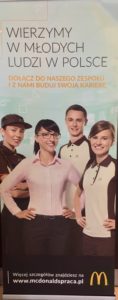 Here is a picture of a life-size advertisement that stands in the entrance area of the McDonald’s in the Służew neighborhood of Warsaw. These are all over Poland, in every McDonald’s. No, I do not eat at Mickey D’s, but when in Poland, I get coffee there daily. It’s handy. The ad is there to attract job applications, “join the team” or some such nonsense. And here are these happy looking employees. They are young, they are attractive, they are very Polish, and the one in front surely hasn’t reached thirty, but is already a manager (as anyone can see from her tailored-to-fit pinpoint oxford, with the tiny golden arches embroidered on –almost civilian dress and not even made of polyester). You too could be her, young Polish person, in charge of this crew, stylish spectacles, respected by your peers, almost making a living wage. What does it say? It says “We believe in young people in Poland. Join our team and build your own career.” All well and good, the image does its job. McDonald’s wants children to exploit.
Here is a picture of a life-size advertisement that stands in the entrance area of the McDonald’s in the Służew neighborhood of Warsaw. These are all over Poland, in every McDonald’s. No, I do not eat at Mickey D’s, but when in Poland, I get coffee there daily. It’s handy. The ad is there to attract job applications, “join the team” or some such nonsense. And here are these happy looking employees. They are young, they are attractive, they are very Polish, and the one in front surely hasn’t reached thirty, but is already a manager (as anyone can see from her tailored-to-fit pinpoint oxford, with the tiny golden arches embroidered on –almost civilian dress and not even made of polyester). You too could be her, young Polish person, in charge of this crew, stylish spectacles, respected by your peers, almost making a living wage. What does it say? It says “We believe in young people in Poland. Join our team and build your own career.” All well and good, the image does its job. McDonald’s wants children to exploit.
But on the table next to the life-size image is this glossy flyer. At first I don’t notice. “Same young woman,” I vaguely think. She does, after all, dominate the scene. 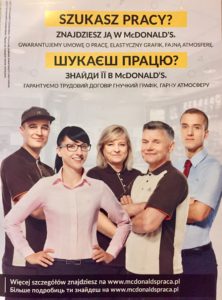 But then something pulls me in for a second look. “Now wait a cotton pickin’ minute,” I think. That’s exactly the same image of that manager woman. I mean, as in, “it’s impossible it could be two different minutes in time.” Not only the exact posture, but each finger and her bangs and her facial expression, no. This is one picture, used twice, and at least one of these is photoshopped. I look closer. Definitely she is photoshopped in the flyer. She floats in front of the others, and she is ever so slightly out of scale –she’s too big. The light isn’t right.
But then something pulls me in for a second look. “Now wait a cotton pickin’ minute,” I think. That’s exactly the same image of that manager woman. I mean, as in, “it’s impossible it could be two different minutes in time.” Not only the exact posture, but each finger and her bangs and her facial expression, no. This is one picture, used twice, and at least one of these is photoshopped. I look closer. Definitely she is photoshopped in the flyer. She floats in front of the others, and she is ever so slightly out of scale –she’s too big. The light isn’t right.
Now, this flyer is not designed to reach exactly the same audience in the same way. It was made to insert into newspapers or to set out at train stations in eastern Poland and western Ukraine. Note that it is in two languages. That is not Russian, it is Ukranian. (Read about that here, it’s excellent.) Poland shares a long border with Ukraine and has a history of excellent relations with western and southern Ukraine.
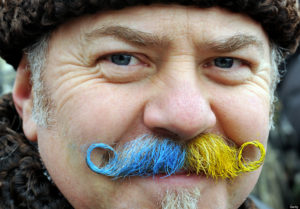 Many Ukranians love Poland and want to live in Poland, where economic opportunities are better and the Russians are further away. Poles are welcoming toward Ukranians (and vice-versa), and for a long stretch of history, a large part of today’s Ukraine was part of Poland. The flyer says “Looking for work? You will find it at McDonald’s” and then goes on about guaranteed work contracts, flexible hours and a comfortable atmosphere. This flyer is for people who have fewer choices than the aspiring youth of Warsaw.
Many Ukranians love Poland and want to live in Poland, where economic opportunities are better and the Russians are further away. Poles are welcoming toward Ukranians (and vice-versa), and for a long stretch of history, a large part of today’s Ukraine was part of Poland. The flyer says “Looking for work? You will find it at McDonald’s” and then goes on about guaranteed work contracts, flexible hours and a comfortable atmosphere. This flyer is for people who have fewer choices than the aspiring youth of Warsaw.
McDonald’s has a decent chance of hiring Ukranians. They need the work, McDonald’s needs the labor, it’s win-win. Sort of. More like, win for McDonald’s, and not starving for the prospective employee, which can be seen as a win. The fellow on the left in the flyer, the tall one, he is definitely supposed to be Ukranian. He has bushy eyebrows, which is a national stereotype. The eyebrows may have been photoshopped. The older fellow on the flyer may be Ukranian or Polish, but the message is, we don’t care if you drove a truck in Crimea before everything went bad, come and work for this stylish, young, Polish manager, or maybe this lanky one on the right, who is even younger, but they are cool and will not mistreat you like Russians would. Both managers are definitely Polish. This is also what passes for diversity in Poland, by the way: people of various ages, weights, and hair color (and variable eyebrow bushiness).
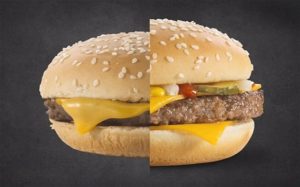 So they imposed a nice picture of a young woman on a different group. So what? And here is a photoshopped McDonald’s hamburger. It isn’t dishonest. The first picture of those workers is photoshopped too. It has to be. The full left arm of the stylish manager appears on the flyer but is covered on the life-size display. The blonde woman in the right foreground has been imposed on the rest of the group. Look closer and see if you don’t agree: all of these people are individual images combined by photoshop. It isn’t hard to see why McDonald’s (or any image-conscious and financially savvy corporation) would do it this way. Let the photographers photograph. Let the graphic artists graph. Let the advertising people advert. Provide the pieces and let the experts do their thing. It isn’t deception, it’s good business.
So they imposed a nice picture of a young woman on a different group. So what? And here is a photoshopped McDonald’s hamburger. It isn’t dishonest. The first picture of those workers is photoshopped too. It has to be. The full left arm of the stylish manager appears on the flyer but is covered on the life-size display. The blonde woman in the right foreground has been imposed on the rest of the group. Look closer and see if you don’t agree: all of these people are individual images combined by photoshop. It isn’t hard to see why McDonald’s (or any image-conscious and financially savvy corporation) would do it this way. Let the photographers photograph. Let the graphic artists graph. Let the advertising people advert. Provide the pieces and let the experts do their thing. It isn’t deception, it’s good business.
But sometimes it goes awry. Here is the cover of the University of Wisconsin’s freshman application from 2001, on the left. On the right is the photograph from which it was made. 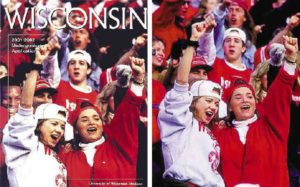 The enrollment people at UW Madison evidently liked this photo and wanted to use it, but there was a diversity issue. No problem. Just photoshop in a diverse person, in this case a smiling and very handsome African American man. But the sun was shining on his forehead in a way that was inconsistent with the rest of the picture and some photoshopcop noticed it. A scandal followed, along with a very public apology from UW. And of course, I’m sure jobs were lost and there was race-shaming and finger-pointing and a backlash, blah, blah, blah.
The enrollment people at UW Madison evidently liked this photo and wanted to use it, but there was a diversity issue. No problem. Just photoshop in a diverse person, in this case a smiling and very handsome African American man. But the sun was shining on his forehead in a way that was inconsistent with the rest of the picture and some photoshopcop noticed it. A scandal followed, along with a very public apology from UW. And of course, I’m sure jobs were lost and there was race-shaming and finger-pointing and a backlash, blah, blah, blah.
So my question is this. I mentioned the fine line between manipulating images with an eye to deception, and just doing so because it’s fun, or because, heck, we’ve always done it. Why does good business practice for McDonald’s translate into dishonesty for UW? How different are the decisions anyway? The UW case is what my friend and fellow blogger Myron Jackson calls “virtual integration,” that habit Americans have of presenting themselves as more racially integrated in TV, movies, media, than we are in practice.  Is it hypocritical to criticize UW for dishonesty when we tolerate all manner of virtual photoshopping of our whole culture? We get riled up when a magazine photoshops a model to make her implausibly skinny, but we wouldn’t mind the McDonald’s scenario? How about if I add the hypothesis that none of those people works for McDonald’s. They are models. Does that matter? Of course not. So, where, oh where is that thin line?
Is it hypocritical to criticize UW for dishonesty when we tolerate all manner of virtual photoshopping of our whole culture? We get riled up when a magazine photoshops a model to make her implausibly skinny, but we wouldn’t mind the McDonald’s scenario? How about if I add the hypothesis that none of those people works for McDonald’s. They are models. Does that matter? Of course not. So, where, oh where is that thin line?
Something about our mythic consciousness hangover is operating here. Childlike belief (all that is good and bad about it) is at odds with our practical need to be told the “truth.” We all want to believe. I leave you with the hypothesis that we don’t like being suckers. But there’s one of those born every minute. I was born at a particular minute. So were you.
